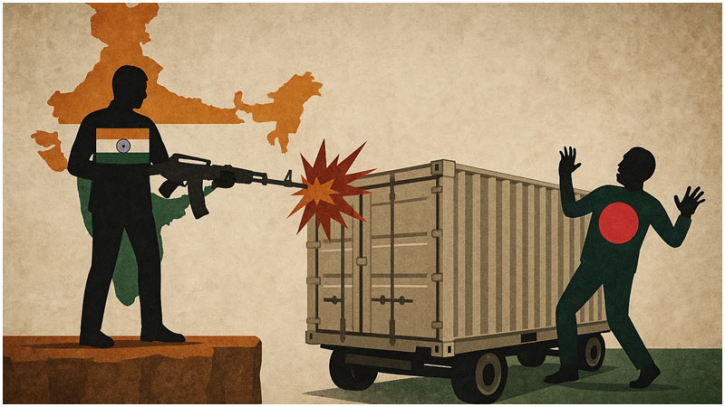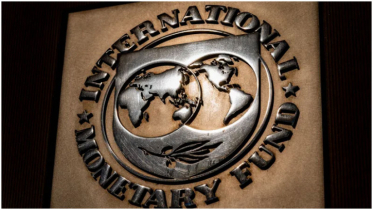India weaponising trade against Bangladesh

India weaponising trade against Bangladesh
Despite persistent efforts, bilateral trade does not always take place smoothly as barriers to trade increase or emerge in new forms for various reasons. Geo-political tension casts a shadow on trade relations disrupting trade. The bilateral dispute also makes things bad, leading to restrictions on trade. The cost of trade disruption or restriction is usually high for both partners. It is, however, higher for countries that used to face trade imbalances. It is also not always easy to remove the restrictions or recover from the disruptions through negotiations, mainly when trade barriers originate in the geo-political dispute. The latest round of Bangladesh-India bilateral trade tension or dispute needs to be reviewed in this perspective.
Last week, India imposed restrictions on imports of certain products from Bangladesh, mainly to the north-eastern states of India through land routes. Under the newly issued order by the Indian government, import of readymade garments (RMG) from Bangladesh will be allowed to enter India only using the country's Nhava Sheva port in Mumbai (western India) and Kolkata port in West Bengal (eastern India). It means, from now on Bangladeshi RMG exporters cannot use any land port to send their consignments to any part of India.
The order, issued by the Directorate General of Foreign Trade (DGFT), also bars the imports of fruits, fruit-flavoured beverages, soft drinks, processed foods, plastic products, yarn, yarn byproducts, and furniture from Bangladesh to the Indian states of Assam, Meghalaya, Tripura, and Mizoram via any land port or land customs station of these states. The restriction also applies to Changrabandha and Fulbari customs stations in West Bengal. So, suppose Bangladeshi manufacturers want to export the items mentioned above to north-east India. In that case, they must send it via Beanpole land port or any other land port or customs station situated on the western border adjoining West Bengal.
Only one (Teknaf) of Bangladesh's two dozen land ports and customs stations is on the Myanmar border; all others are on the Indian border. The DGFT order, however, does not restrict Bangladeshi exports to Nepal and Bhutan transiting through Indian territory.
The recent decision to limit the entry points of Bangladeshi products is a significant bilateral non-tariff barrier (NTB) imposed by India. The Global Trade Research Initiative (GTRI), based in New Delhi, estimated that India has restricted 42 per cent of imports from Bangladesh, affecting over $770 million worth of goods. While India does not outright ban or impose wholesale restrictions on the imports of the above-mentioned goods from Bangladesh, the requirement to use only limited points and long routes significantly increases the cost of exporting to India from Bangladesh.
It is clear that the NTBs will have a significant negative impact on Bangladesh's export earnings if the barrier persists. The exports will be affected negatively in two ways, potentially leading to a substantial economic loss.
First, readymade garments (RMG) exports to India will also face a serious setback as around two-thirds of the exports were shipped through various land ports. Around 500 industrial units of Bangladesh exported RMG worth $555.7 million to India in FY24, many of which are small and medium enterprises (SMEs). The SMEs will be unable to bear the high shipment cost via sea ports.
Secondly, Bangladesh is at risk of losing a dedicated market that has developed over the decades in the north-eastern states of India. Most of the exporters are SMEs, and it will not be feasible for them to supply the products crossing over a thousand extra miles. The Indian imports based in the northeast, the so-called seven sisters, will also not be interested in paying a high price to cover the additional cost. This potential loss is a cause for concern.
Though India's imposition of these NTBs is fuelled by a number of factors, as mentioned by many, including Indian media, the core thing lies behind the ouster of the Hasina regime August last. The fall of the Hasina regime, strongly backed by New Delhi over the years, was a big upset for the Indian establishment. The anti-discrimination movement, launched by students, turned into a mass uprising against the oppressive regime of Hasina. To curb the rebellion, the fallen regime resorted to brutal force, killing 1,400 people in less than three weeks. More than 20,000 people were injured also. Nevertheless, Hasian was forced to resign on August 5 last year and flee to New Delhi for shelter.
Since then, India has yet to fully recognise the changed reality in Bangladesh, which is reflected in a series of moves and steps taken by the Indians and also intensified anti-India sentiment in Bangladesh. To put pressure on the Yunus-led interim government in Bangladesh, which the Modi regime branded as friendly towards Pakistan and China, it (India) has also started to use trade-related tools. Last month, India cancelled the transhipment facility given to Bangladesh for third-country export using the Indian sea and airports. As an apparent counter-move, Bangladesh banned yarn imports through the Benapole, Bhomra, Banglabandha, Burimari, and Sonamasjid land ports. Thus, yarn from India can now be imported through seaports. As India has been supplying around 80 per cent of Bangladesh's annual demand for yarn for the export-oriented garment industries, the restriction makes the import time-consuming and costly.
This scribe in this column last month noted: "Equipped with a number of tools in hand to make the international trade of Bangladesh costlier, New Delhi is better positioned to exert pressure on the Yunus-led government further. So, it is not unlikely that Bangladesh will face more trade restrictions from India in the coming days." (Rising risk of Indo-Bangla trade retaliations: The Financial Express, April 20, 2025). The latest move by India shows that things are going in the predicted direction.
Using trade as a weapon to exert pressure on other countries to express discontent or anger is not unique to India. For India, it is also not a new thing. Around six years ago, India imposed a ban on imports of palm oil from Malaysia after Kuala Lumpur had criticised New Delhi's oppressive move against Kashmir and Indian Muslims. At that time, India also increased imports from Indonesia. Although the dispute was resolved later, India found that through trade restrictions, it could effectively manoeuvre its geo-political interest.
So, will the latest trade restrictions be effective in putting pressure on Bangladesh? There is no simple answer despite the fact that the direct impact of the NTBs is costly for Bangladesh. Moreover, bilateral relation may deteriorate further which will be also troubling for both the countries in the long run. Reviving the effort to minimise the trade restrictions is thus necessary no matter how difficult it is.
Source: The Financial Express.
.png)




